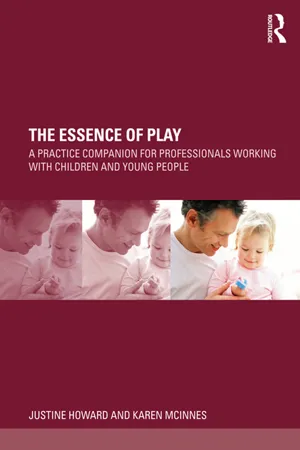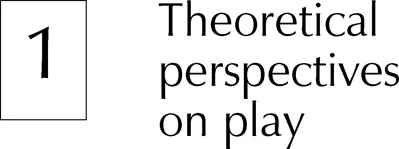![]()
Aims of the chapter
- To discuss different types of play practice.
- To identify the theories and theorists underpinning the different play practices.
- To discuss how this results in a lack of shared practice among play practitioners.
- To identify points of common practice between play practitioners.
Introduction
Play has been the subject of theoretical musings throughout history. Since the time of Aristotle and Plato, the value and benefits of play have been debated and discussed, and different viewpoints and definitions have been put forward (Cohen, 2006). Consequently, there is not one, clear theoretical view or definition of play. This chapter will acknowledge this theoretical diversity by identifying theorists of play and their unique contribution to our growing understanding of play. However, instead of taking a chronological approach to developing play theory this chapter will look at how theory has developed and underpinned different play practices. It will identify the theorists who have contributed to the theory underpinning educational, therapeutic and recreational play practice. It will look at how these theorists have defined play and their key ideas about play, and where there is overlap between ideas and different play practices. It will also consider how these different theoretical standpoints have contributed to our view of children and how we engage in play practice with them. It will also identify those rare theorists who cannot be pigeonholed as their ideas cross all play practice boundaries.
There are many theories and theorists of play, each one emphasising a slightly different view of play and the value and benefits that might be derived from engaging in play activities. All types of play practice are based on theoretical understanding. There are considered to be three distinct play practices: educational, therapeutic and recreational (Sheridan, Howard & Alderson, 2011), and practitioners within each of these categories tend to understand and value play in different ways. Educational play practitioners tend to value play as tool to aid learning and development (e.g. F. P. Hughes, 2010). Therapeutic play practitioners tend to value play as a medium of communication to enable social and emotional growth in children facing difficult life events (Axline, 1979), while recreational play practitioners value the inherent freedom that children have as they engage in play (Else, 2009). Each of these types of play practitioner draw on relevant and appropriate theory to support their view of play. At times the theorists and theories utilised are unique to that type of play practice, for example, Klein [1882–1960] and therapeutic play practice while others cross practice boundaries, for example, Sutton-Smith (1997). These theorists of play also tend to have slightly different definitions of play.
Defining play is fraught with difficulty. It means different things to different people (Howard, 2002), with some commentators of play stating that play is impossible to define (Moyles, 1989), although many of the theorists discussed below have made the attempt. Theorists such as Piaget (1951) defined play according to categories of practice play, symbolic play and games with rules, while Hughes (2006) has identified different play types. Others have tried to define play according to criteria or dispositions such as play being pleasurable and voluntary (e.g. Rubin, Fein & Vandenberg, 1983). However, these ways of defining play are not necessarily helpful to play practitioners. Most play practitioners discuss creating the right conditions or context for children’s play (e.g. Brown, 2008), while others identify play as a behaviour or types of behaviours (e.g. Burghardt, 2011). Many play practitioners view play as a disposition or a way of being emphasising the positive sense of self and wellbeing that comes with play (e.g. Isaacs, 1929). This is often viewed alongside a definition of playfulness, something that is viewed as separate from play (e.g. Dewey, 1933). All play practitioners would probably agree that play is a process, and many theorists discuss play in this way. But this opens up as many definitional problems as it solves. How the process is defined and what exactly constitutes the process probably mean different things to different people. In discussing theorists of play their definitions will be considered according to whether they view play as behaviour, context or disposition as well as process, and how this influences play practice.
Historically, children have been perceived in different ways dependent upon the prevailing views and needs of the time — from Locke’s view of the child as a tabula rasa to Rousseau’s view of childhood as an age of innocence. In more recent times children and childhood have been viewed as a social and cultural construction, with debate concerning whether children are viewed as a progressing through a natural state on the way to adulthood (becomings) or as individuals in their own right (beings) (James, Jenks & Prout, 1998). There are some who view children as both beings in the here and now and as becomings given the natural development and growth that children go through (Lee, 2002). According to current discourses, children are seen as active agents in their lives, should have a say in their lives and be heard by those who work with them (James et al., 1998). In addition, Dahlberg, Moss and Pence (2007) state that views of childhood and children are ‘productive of practice’ (p. 52), and this can be seen in the way that play theorists influence practice and ultimately the view of the child. The discussion of theorists below will identify the likely view of the child, as being or becoming, implied from their theoretical position on play.
Theorists and theories of play
The following discussion of theorists and theories of play will be primarily organised according to type of play practice: educational, therapeutic and recreational. Some theorists cannot be categorised in this way, and they will be identified and discussed separately. There are also those classical, philosophical theories that are cited by all, irrespective of play practice. These theories provide a starting point for any theoretical discussion of play despite having limited application to the theorists and theories that have followed, but in terms of historical referencing they are important.
Classical theories of play
These early philosophical theories of play have previously been presented as opposing pairs (Saracho & Spodek, 1998). The surplus energy theory of play proposed by Spencer [1820–1903] stated that play was a product of superfluous energy left over after all other basic needs had been met. While the relaxation theory of play by Lazarus [1824–1903] took an opposing view, rather than seen as using surplus energy, play was an activity that occurred after work in order to relax and build up further energy. The recapitulation theory of play by Hall [1846–1924] saw the function of play as cathartic in that through playing children acted out evolutionary stages, while the pre-exercise theory by Groos [1861–1946] explained play as an opportunity to practise adult activities and prepare for adult life. Certainly these types of activities can be seen in children’s play today, and many early years education practitioners will justify play in the curriculum in this way.
All of these theories may be considered as a reflection of the time period in which they were proposed. They are all defining play as a behaviour or an activity in which children naturally engage. As a naturally occurring behaviour there would be little consideration of the context of play or play as a disposition. The view of the child implied by these different theories is also a reflection of the times. The first two theories
Table 1.1 Classical theories of play | The orist | Key ideas | Definition of play | View of child |
Spencer
1820–1903 | Product of excess energy | Behaviour | Being |
Lazarus
1824–1903 | A form of relaxation after work | Behaviour | Being |
Hall
1846–1924 | Cathartic, play out evolutionary stages | Behaviour | Being and Becoming |
Groos
1861–1946 | Preparation for adult life | Behaviour | Being and Becoming |
imply that childhood is a time of being, with no sense of becoming. In the early 1800s children were expected to help with the daily life of the family from a young age. They were often exploited to the detriment of their education. However, by the late 1800s young children’s education was taken more seriously, and there was a recognition that education would provide a more effective workforce later on (Fawcett, 2000). Hence, the two later theories may be considered as viewing children not just as beings but also as becomings through the cathartic and skill-based experience of play. An overview of these theories is provided in Table 1.1.
Theorists of educational play practice
Froebel [1782–1853] is a key theorist underpinning early years education. He invented the first kindergarten (literally, young children’s garden) in Germany and saw play as central to children’s learning and development. He espoused open-ended, real experiences for children without rules imposed on them by others — quite different to views of play within education today and more in keeping with recreational play practice. Froebel saw play as an integrating mechanism that brought all aspects of development together. He developed his Occupations — a range of craft-like activities and Gifts — a set of wooden blocks with endless possibilities for open-ended play and learning (Bruce, 2011). Froebel’s view of play may be defined as a disposition, behaviour and process as children are able to wallow in play as well as developing through play, hence both being and becoming.
Dewey [1859–1952] is often mentioned in educational texts but rarely in texts on play. However, he was possibly the first theorist to clearly differentiate playfulness from play. He stated that ‘the former is an attitude of mind; the latter is an outward manifestation of this attitude’ (Dewey, 1933, p. 210). In this way it would seem that he saw play as a behaviour and playfulness as a disposition. This view would have resonance with both therapeutic play practice, where theorists also emphasise playfulness in a similar way, and with recreational play practice through play as behaviour. As an educationalist he saw education, and presumably play, as a means for growth, so viewing childhood as a time of becoming.
Like Froebel, Montessori [1870–1952] is a key theorist underpinning early years education. However, her views on play are less in keeping with current early years play practice. She saw play and work as synonymous, usually referring to work as the child’s life in progress, which the teacher should respect and enhance (Montessori, 1965); this would lead to growth of the child, hence she saw the child as becoming. She believed that children should have freedom to choose what to play, but children were taught to use materials in a didactic way and not use them in any other way, a far cry from recognised play practice. By using carefully graded materials in a set way children were then free to learn by themselves.
Susan Isaacs [1885–1948] was a psychologist who was also influential within the development of early years education. She valued the practical activities and interactions children engaged in while playing as these supported a positive sense of self, which would lead to intellectual development. However, Isaacs also valued children’s spontaneous play, especially play without adults, as children may behave differently and by observing adults could gain new insights into the child (Isaacs, 1932). In this way her view of children could be interpreted as being and becoming. The emphasis on the positive sense of self through play is shared with therapeutic play practice.
Piaget [1896–1980] was also a psychologist whose ideas have been influential within education. His theory of play (1951) was an extension of his work on intellectual development. He also defined a stage theory of play that reflected levels of intellectual development. Piaget’s concept of play derived from his concept of assimilation, and he saw play as secondary...

